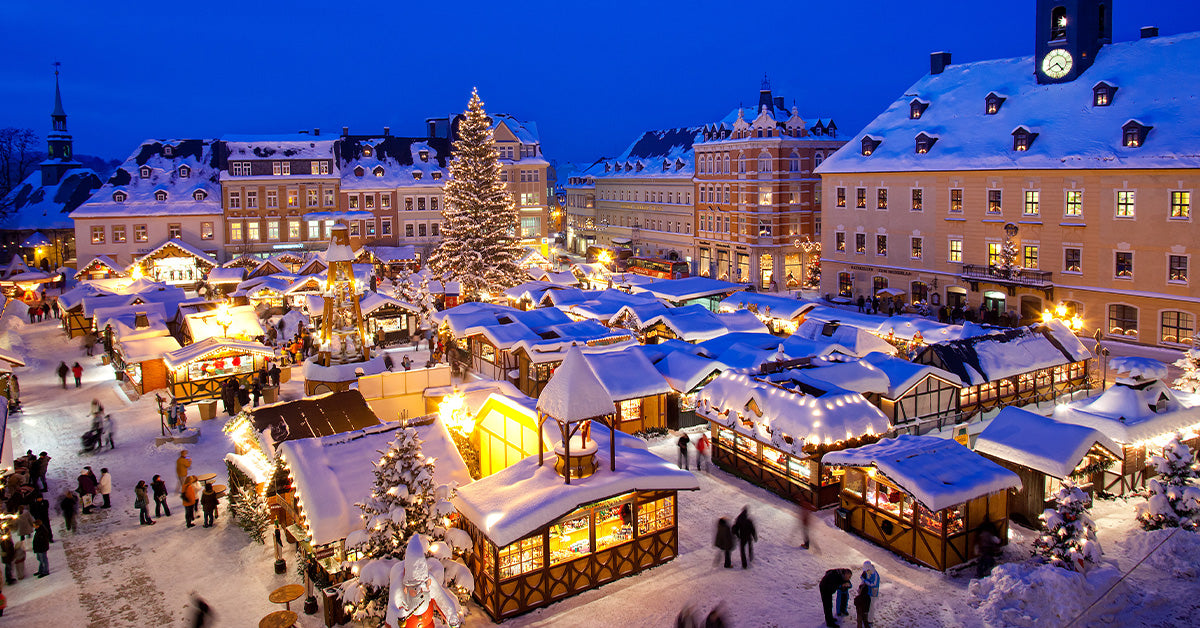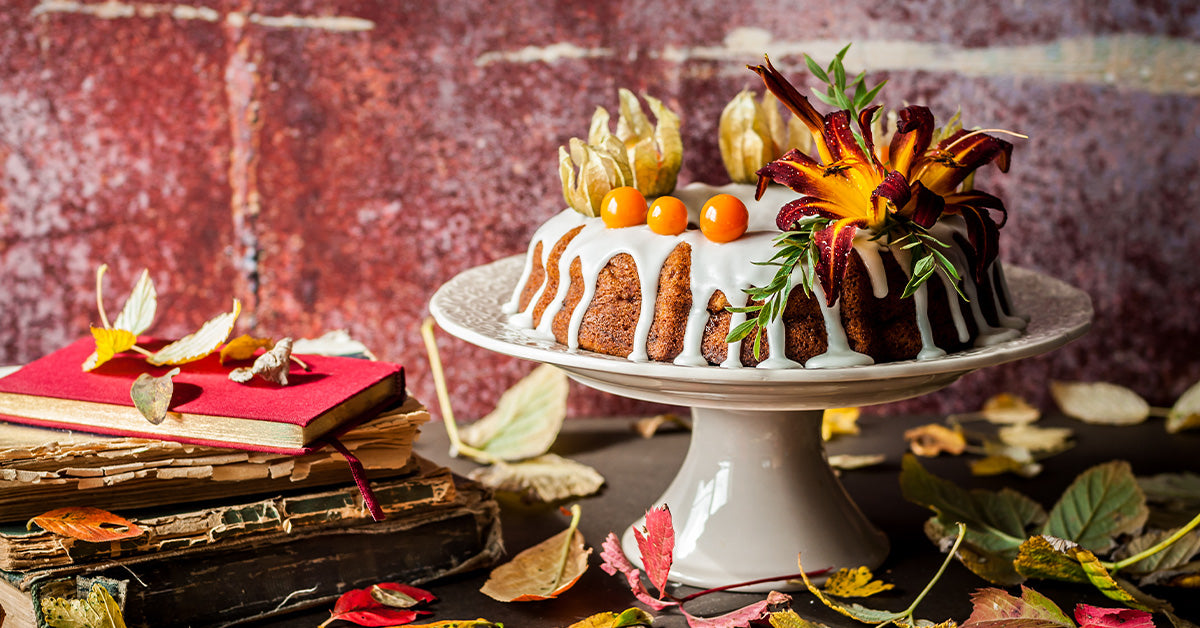If you’ve ever been to a Christkindlmarkt during the holidays, you know how special they are – it’s like walking straight into a German town. The sights and smells are all old-world holiday, and when you look down, you’re surprised to find you’re not wearing lederhosen. But you just smile because the warm mug of Glühwein – mulled wine – you’re holding makes everything alright.
Our Harneymarkt this holiday season was obviously inspired by this wonderful German Christmas tradition. Ever wonder how they came about? It’s interesting, and the ways that events surrounding German Christkindlmarkts have influenced our own celebrations may surprise you.
The history of these markets actually dates back to the 13th century. Starting around 1296, Vienna’s Emperor Albrecht I granted shopkeepers the right to hold a market for a day or two in early winter so townspeople could stock up on supplies to last through the cold months. Known as Dizembermarkt, over time, shopkeepers began setting up stalls to sell things like baskets, toys, and more that were bought as gifts. These winter markets eventually became known as Christmas markets; the earliest appeared in Munich around 1310, Bautzen in 1384, and Frankfurt in 1393. But the first true Christmas market is attributed to Dresden’s Strietzelmarket in 1434.

By the mid-1500s, Christkindlmarkts were a common sight throughout Germany. Each town had their own unique market where local farmers, bakers, and tradesmen sold their ware. This gave each market distinctive characteristics. Just as you can today, shoppers then could expect to find hand-carved nutcrackers and other wooden toys, cuckoo clocks, glass, small wooden ornaments, beer steins, along with food and beverages, of course.
One big boost to the Christkindlmarkts – and our own Christmas traditions today – came from an unexpected source: the German Protestant reformer Martin Luther. Before he came along, the exchange of Christmas presents took place on either the Saint Days of St. Nicholas or St. Martin. It was Luther’s idea that gift-giving should be focused around the birth of Christ rather than saints – that children should receive gifts from the Christ Child or Christkind. His idea was obviously adopted.
Rather than representing the Christ Child, the “Christkind” is a fairy-like being dressed in gold and white robes with a crown on golden hair who is the namesake of Christkindlmarkts. This figure, who is present at many Christkindlmarkts and is the German equivalent of Santa Claus, was derived from traditional costumes where parades during the holiday season were guided by a grand angel, the Christkind. It is she who delivers presents under German Christmas trees and disappears before children can see her.
Christkindlmarkts have obviously fanned out across Europe and the U.S. and have become extremely popular holiday events. If you go, you can expect to enjoy some typical German fare like the aforementioned Glühwein as well as Apfelwein (hot cider), Eirpunsch (egg-based warm alcoholic drink, much like eggnog), Christstollen (egg bread with fruit), Bratwurst (you know what that is!), giant pretzels, roasted nuts and much more. If you’re lucky, you’ll find Zwetschgenmännle – adorable little prune people. And if you’re at a Christkindlmarkt in Catalan, Spain, you won’t be able to miss the Caga Tió, or Tió de Nadal…or the “pooping log.”

(It’s a long story, but this very popular Catalan tradition involves this adorable log wearing a cape with a smiling face that is “fed” for a period of time before Christmas. On Christmas Eve, while the children leave the room to pray for the Caga Tió to leave them sweets and treats, parents hide small gifts under the blanket that has been placed on top of the log. Then the children sing a song to entreat the log to “poop” out gifts for them as they beat it with a stick (we can’t make this up). The log, having been “fed” food for a week, has no reason not to oblige; treats and sweets are found under the blanket by delighted children. And that, folks, is a Christmas tradition we’re pretty sure not many of you knew! You’re welcome.)
We hope you’ve enjoyed learning all about Christkindlmarkts and are able to enjoy our own Harneymarkt this season. Just like the local tradesmen of yore, we’ve filled our stalls with our own unique Harney wares and gifts. Schöne Feiertage – or Happy Holidays!




6 comments
Margaret Pfister
In paragraph 5, they are called “Feast Days” not “Saint Days”.
In paragraph 5, they are called “Feast Days” not “Saint Days”.
Nancy Klammer
Just returned from a Danube River Christmas Markets Cruise from Nuremberg to Vienna and love hearing this history!!
Just returned from a Danube River Christmas Markets Cruise from Nuremberg to Vienna and love hearing this history!!
Calee
My husband and I visited Germany this fall for the first time. We visited many Christmas shops in one small medevil German town called Rothenberg on der Tauber. Love this background on the Christkindlmarkts! Thank you 🌲!!
My husband and I visited Germany this fall for the first time. We visited many Christmas shops in one small medevil German town called Rothenberg on der Tauber. Love this background on the Christkindlmarkts! Thank you 🌲!!
Donna
What a wonderful article. It brought back so many good memories of my first Christkindlmarkts in Germany! You so captured the spirit💕🇩🇪
What a wonderful article. It brought back so many good memories of my first Christkindlmarkts in Germany! You so captured the spirit💕🇩🇪
Jim Bryce
What a wonderful story. I am sure most people did not know the origin of the Weihnachtsmarkt. This year, I will be travelling to Germany to enjoy the excitement and social gatherings of Christmas and the market celebrations.
What a wonderful story. I am sure most people did not know the origin of the Weihnachtsmarkt. This year, I will be travelling to Germany to enjoy the excitement and social gatherings of Christmas and the market celebrations.
Andrea G.
What a delightful read about Christkindlmarkts! The photos of the lighted, snowy market brought back memories of being at one of those markets a few years back. I will be making the Pumpkin Spice ring cake….it looks festive and delicious. Thanks for the recipe and your superb teas!!!
What a delightful read about Christkindlmarkts! The photos of the lighted, snowy market brought back memories of being at one of those markets a few years back. I will be making the Pumpkin Spice ring cake….it looks festive and delicious. Thanks for the recipe and your superb teas!!!